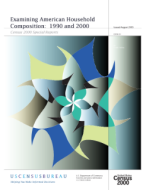
An official website of the United States government
Here’s how you know
Official websites use .gov
A .gov website belongs to an official government organization in the United States.
Secure .gov websites use HTTPS
A lock (
) or https:// means you’ve safely connected to the .gov website. Share sensitive information only on official, secure websites.
-
//
- Census.gov /
- Library /
- Publications /
- Examining American Household Composition: 1990 and 2000
Examining American Household Composition: 1990 and 2000
Examining American Household Composition: 1990 and 2000
Abstract
In 1880, the U.S. Census Bureau began asking a question in the decennial census of population to determine how each person living in a household was related to the head of the household (or the householder, in current terminology). From this information, all individuals can be tabulated according to their relationship to the householder, such as spouse, child, etc., and households may be classified as belonging to a particular type, such as married-couple, nonfamily, etc. This report uses the latter approach, classifying households, and shows tabulations of households within specific individual relationships and certain broader household-type classifications.
Beginning in the 1990 census, relationship data included separate precoded classifications for unmarried partner, stepchild, and grandchild. Census 2000 added more precoded categories (foster child, adopted child, parent-in-law, child-in- law) and obtained more detailed information about relationship than did previous censuses.
The new information collected in the relationship-to-householder item reflects the growing complexity of American households and creates an opportunity to enhance our understanding of how the U.S. population collectively lives in households. Since the general classifications used to group household types changed minimally over the last half of the 20th century, the traditional aggregations may not fully reflect this increased complexity.
Others in Series
Publication
Publication
Publication
Share
Related Information
Some content on this site is available in several different electronic formats. Some of the files may require a plug-in or additional software to view.
 Yes
Yes
 No
NoComments or suggestions?


Top

